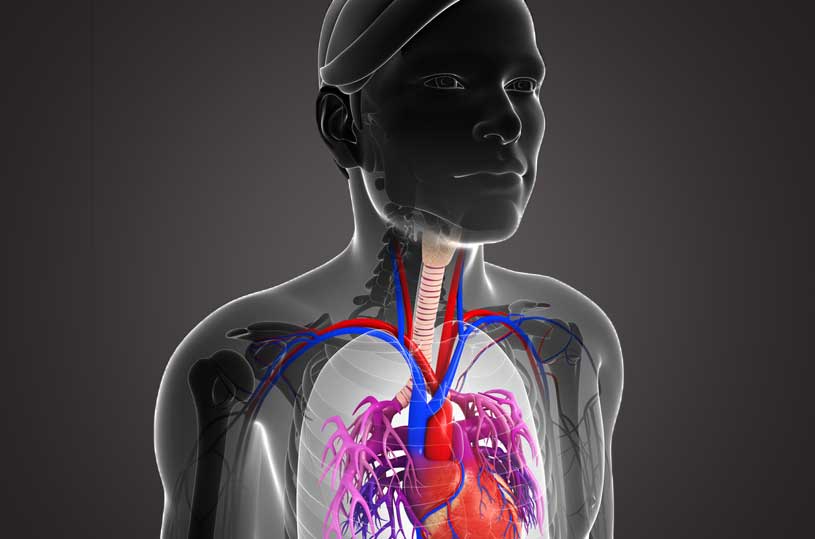“Let him just cry!”
This is perhaps the only time in life in which the parents want their child to cry. This first cry tells us that “all is well” with our newborn baby. But why does the baby really have to cry?
First, a few words on the heart of the fetus, which differs from the heart of the adult: Since the baby's lungs do not function when they are filled with amniotic fluid, the heart bypasses the lungs and the blood flows from the placenta through the right side of the heart directly to its left side without passing through the blood vessels in the lungs.
At birth a baby is born wet from amniotic fluid, when exposed to the air it cools his skin activating a reflex that causes him to cry. In order to cry, he must take one deep breath when exposed to the cold air let it out with a shout. But how can breathe? Until now the baby didn't breathe on its own, since its lungs were full of amniotic fluid and didn't yet function!

Indeed, the baby's lungs didn't breathe yet. They are still full of amniotic fluid, and the newborn is in danger of drowning. But at that special moment, the body takes action that awakens the lungs: the adrenal glands secrete adrenaline hormone through the whole body. The muscles needed for breathing – the diaphragm and the muscles between the ribs – suddenly contract, and the baby takes its first, most important breath. These processes create pressure changes that increase blood flow to the baby's lungs. Now, every baby's breath will absorb oxygen into his blood vessels.
At the same time, a large amount of blood from the placenta is squeezed – through gravity and contractions of the uterus – into the baby's heart. This increases blood flow to the lungs. As a result, the hole between the two sides of the baby's heart suddenly closes, and the lungs become the only place where the baby can get oxygen.
And what about the amniotic fluid remaining in the lungs?
A baby's crying not only increases the blood flow to his lungs, and changes his heart's structure closing it into a single unit. His crying also helps him get rid of excess amniotic fluid in his lungs. A baby who didn't cry enough may suffer respiratory distress due to residual amniotic fluid that has not been ejected or absorbed.
Needless to say, scientists have no answer about the “timing” of the fetal blood vessels closing and the structural changes in the baby's heart which enable him to live.
An atheist's conversation with G-d
After his death, an atheist spoke with God:
G-d asked him “Why didn’t you believe in me?” The question echoed in the air…
The atheist tried to justify rationalize: “I did not believe in you, because I saw no proof of your existence.”
Just then the earth trembled…
Suddenly the atheist saw thousands of pictures he had seen in his life. He saw pictures of the universe, of the sky, the solar system, the moon, clouds, of animals (horse, elephant, bee, cat …), humans (man, woman, old man boy and a baby. He saw pictures of nature: rain, snow, lightning and thunder, mountains and valleys. He saw fruits and vegetables of all kinds and all kinds of colors. He saw human organs: arteries, veins, heart function, lungs, digestive system, eye structure, brain structure and functions. He saw emotions, thinking, perception and memory. He also saw the wondrous and inconceivable process of becoming a healthy baby, his internal organs forming in his mother's womb, birth, childhood and adolescence that every person goes through.
The atheist understood that the whole universe was made up of parts that fit together like a puzzle and a marvelous design…
Then G-d called slowly and sorrowfully: “Did you really think all this created themselves, without thought or intention? Wasn't the world I created complex and planned enough that you could deduce my existence from it?”
The atheist did not know what to answer. After all, even a child can understand that the world was created with tremendous intent. It should be even more obvious to an intelligent adult and scholar like him. So how could he deny such a simple truth?
(From the booklet “A fateful conversation” – Rabbi Daniel Balas)
Snowflakes
A close look at snowflakes shows us how beautiful and complex they are. Snowflakes, coming in a variety of engineered forms, astonishing in their precision and beauty, raising the question – how did this wonder come about?
The crystals of ice join together, connecting in a symmetrical, beautiful and perfect way to form snowflakes. This precision creates the unique shape of the snowflake. On a snowy day countless flakes descend. Of all those flakes from the past to the future, not a single flake is exactly the same!

It's beyond man's comprehension to fathom the creation of such perfect symmetrical beauty, repeating itself countless times, creating a different form each and every time. Surprisingly, the Creator ordered that all the various forms of snowflakes be of a hexagonal structure – always with six angles!
Snowflakes are more beautiful than the most decorated jewelry. They reflect something sublime, the creation of a master! Is it possible that snowflakes, with their wondrous symmetries and spectacular shapes were formed without a higher hand directing and watching them?
I Want to see miracles!
If the Creator would only do one miracle for us, we would immediately strengthen with faith and never lose it, so we imagine. Is that really so?
The truth is that miracles take place, at every moment, everywhere, if we look. But we ignore them out of habit.
To see miracles we will have leave habit and rigidity, to try seeing things objectively without bias. Why don't we appreciate rain? The earth's precise rotation around itself and the sun? A tree laden with delicious fresh fruit which grew from a piece of a rotted seed? The precise and wondrous development of a fetus in his mother's womb?
Try to define the term “nature.” We include in it all the incomprehensible things that supposedly occur on their own. If we really try to define the concept of “nature,” we will discover that nature is all of the miracles the Creator does before our eyes at any moment which we already got used to.
Miracles are completely “dressed” in nature, and are not seen as miracles. Chazal warn: “The beneficiary of a miracle does not recognize his miracle.” Meaning when a person has a miracle done for him, he himself is not aware of the miracle done for him.
Try to forget habits, let go of bias and look around. You don't need much effort to see great miracles, just open your eyes and look…
“Gatekeepers” of the eyes
Do we really need our eye lashes? What if our eyes had no eyelashes?
The eye lashes are thin hairs that grow at the edge of our eyelids serving as gatekeepers for our eyes.
Our eyes keep themselves clean and moist because of a reflex of the eyelid. This reflex is activated by receptors in the eyes and eyelashes. When something touches the eye, or when the eye starts drying, the receptors make us blink, protecting the eye from foreign objects injury and dehydration.

The lashes are very sensitive to the touch, and warn us when a foreign object like dust or an insect come near the eye. They feel the foreign object approaching and order the eye lids to close. The eyes close reflexively when the eyelashes feel foreign objects.
In fact, without eyelashes, we would suffer from chronic eye infections, irritation, dehydration and even permanent eye damage. We would not be able to drive, walk down the street or read from the board. We would not be able to see anything.





